Disney has a reputation for being on the leading edge of attraction design. Audio-animatronics, water propelled dark rides: in the theme park industry, Imagineers are the top dogs when it comes to innovative attractions.

Still, for all Disney has done, there’s a great big beautiful tomorrow out there and many new technologies that we can’t wait to see come to the parks!
Stuntronics: Bringing Superheroes to Life
One of the more spectacular forms of in-house innovation at Disney are the Stuntronics. These self-contained audio-animatronics are designed to do feats of superhuman acrobatics!

Using artificial intelligence, these acrobatic androids can precisely calculate their trajectory through the air, making realistic adjustments to ensure a safe and spectacular landing. Disney has made a lot of progress on this technology. In fact, they’re bringing one to Disneyland in 2020, with a Spider-Man Animatronic coming to the Avengers Campus at Disney California Adventure. Spidey will be entertaining guests with dramatic flips and leaps over the W.E.B. complex... but that’s only the beginning.

These animatronics can be used for spectacular effects and can also move real performers out of harm’s way. Take Happily Ever After at the Magic Kingdom. One of the climactic scenes features Tinker Bell “flying down” on a zipline from the castle shortly before fireworks erupt from the castle. Needless to say, this is a dangerous feat. While no accidents have occurred, the performer playing Tinker Bell does take a risk every time she clips in. A stuntronic can be used to provide a similar effect without putting anyone at risk of injury or death.
Stuntronics can also be used for places where a live performer is impractical, like on dark rides. For a stunt to be part of a dark ride, a performer would need to move past every time a vehicle passed through the scene, which could be many times an hour. Cycling stuntronics could allow such a stunt to be performed multiple times an hour, creating a level of realism that would currently require screens or projection mapping to achieve.
Speaking of animatronics…
Living Characters
The Living Character Initiative was a project developed to create super realistic characters, including animatronics and digital puppets, that can freely interact with guests. Longtime readers will remember Lucky the Dinosaur, the Muppet Mobile Lab, and the Remy animatronic at Chefs de France. These were all live sized, realistic characters that could interact with guests in real time, often with the aid of an undercover operator. While a lot of these animatronics are no longer in the parks, several elements of the project are, including Monsters Inc. Laugh Floor and Turtle Talk with Crush, both of which rely on a digital puppetry system that allows an actor to manipulate an animated figure in real time.
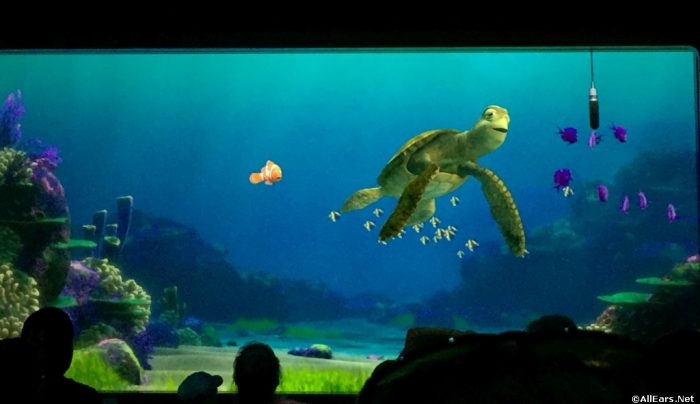
In fact, here’s something fun. Do you remember Waldo, the “Spirit of 3D” that plays such a major role in Muppet*Vision 3D? He’s not just a 3D effect; when the film was being made, he was controlled in real time using a motion capture device called… wait for it… a waldo! He’s just as much a puppet as the rest of the Muppets, but you’d never be able to tell by just watching the movie. Pretty cool, huh? This clip from The Jim Henson Hour shows how it was done.
Now, years later, we can produce a movie quality effect in real time, and that’s not the limit of what the technology can do, either!
Modern animatronics, like Hondo Ohnaka on Galaxy’s Edge’s Millennium Falcon: Smugglers Run, are more advanced than anything Disney has put out before, capable of producing incredibly realistic motions. Plus, it’s easier than ever to make fully mobile animatronics. The R2-D2 Living Character at Galaxy’s Edge is stable enough that Disney is actually selling them to the public. Who knows what could be done in the future? Dok-Ondar interacting with guests? A life-sized Donald Duck waddling around the parks? The sky is the limit!
Gamification
Back when Kim Possible was a thing, the idea of a personal computer device on the level of the Kimmunicator was science fiction. Now it’s available for less than $100 at your local Walmart.
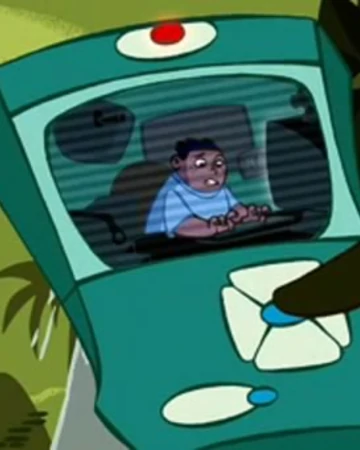
You just heard the ring tone. ©Disney
When the World Showcase Adventure first opened, Disney had to loan cellphones to guests so they could participate. Now that they’re so ubiquitous, Disney’s been using the Play Disney Parks app to add levels of interactivity to the park. You can play self-contained games… or you can do what Galaxy’s Edge did.
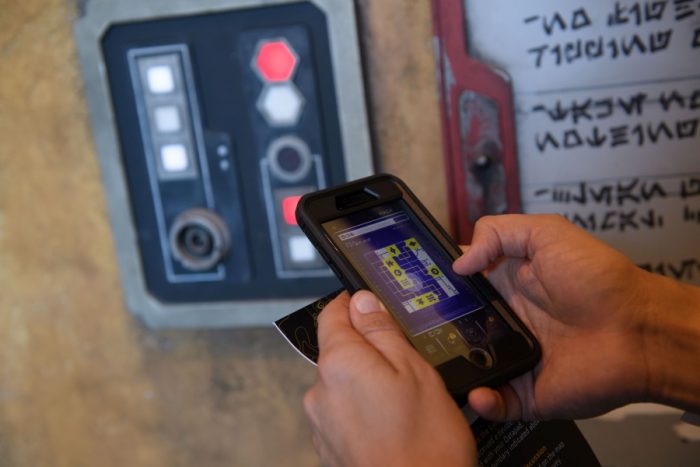
This land is intricately bound to the Play Disney Parks app, reacting to things you do and remembering your progress between visits. While it’s not quite as advanced as it could be (an early draft of the park had bounty hunters seeking out guests who did poorly on Smugglers Run, as the ride records your progress). The upcoming Galactic Starcruiser is set to take it a step further, using the app to record your progress in the hotel’s storyline.
But there’s so much more that can be done. Experiences like Sorcerers of the Magic Kingdom and the World Showcase Adventure provide unifying experiences for the entire Park. In this age of deep immersion, more parks are turning to games to help tell a story. Super Nintendo World, coming to Universal Orlando, uses a wristband system to keep track of a visitor’s score, with rumored console interaction. Disney World already has the infrastructure in place with the Play Disney App and MagicBands (which use long-range RFID to interact with some attractions). We’re entering the age where theme parks can be part of huge, immersive narratives where you, the guest, are the star!
Virtual Reality
VR is, in all honesty, kind of controversial as a Theme Park technology. Don’t get me wrong, Disney has done some cool things with it. In fact, Disney created one of the first-ever VR Theme Parks, long before companies like Oculus made the technology lightweight and accessible.
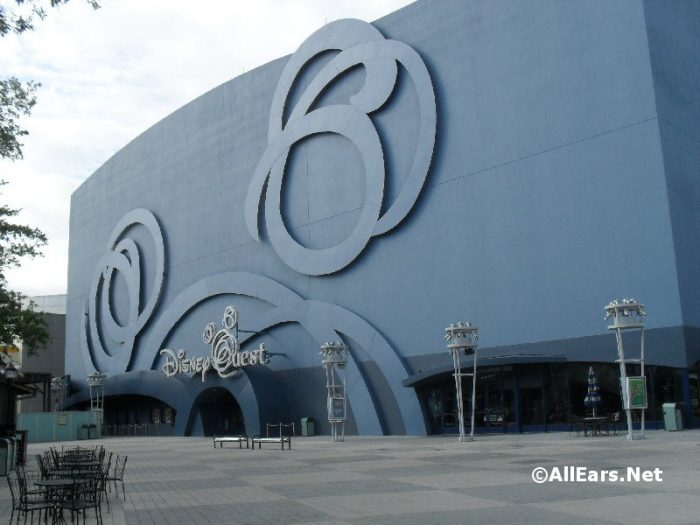
DisneyQuest was ahead of its time and promised to bring the Disney Parks experience to locations around the world. However, technology quickly moved beyond the attractions provided, no matter how groundbreaking they originally were, and the attraction shuttered. Now, VR technology is lightweight and widely available, but it has a reputation in the themed entertainment industry as being something of a cheap gimmick. This is largely because many parks experimented with adding VR to existing attractions like roller coasters and drop rides, often using video-game like environments and poorly calibrated head tracking. As if a coaster wasn’t motion sickness-inducing enough!
But, perhaps most of all, some VR experiences simply aren’t Disney. Yes, they can be beautiful and innovative, but you don’t always feel like you’re there. You feel like you’re sitting on a roller coaster with a pair of goggles on your head. Even at The Void in Disney Springs, which takes great pains to simulate the experience of actually being in a different world, there were gaps in the experience. I’d reach out to feel a wall, only for my hand to meet empty space. I couldn’t tell what had a real world counterpart and what was strictly virtual, which was disorienting. As amazing as it was, it could have been so much more… and Disney can do so much more.
One example of good VR in a theme park is the current iteration of Derren Brown’s Ghost Train at Thorpe Park in the UK. This is a mixed VR Dark Ride/Haunted Maze attraction that uses VR to great effect. First off, guests are given an in-universe reason to be wearing VR Goggles; they’re masks that protect against a hazardous gas filling London. The virtual environment also matches perfectly with the actual ride vehicle because it is the ride vehicle; the show was filmed inside the set from the rider’s fixed perspective and ported to VR. The only weakness is that your fellow riders seem to disappear… which is addressed in the second half of the attraction. After a frantic run through monster infested subway tunnels, you’re rushed back onto the train and redon your goggles. At this point, the reboarding process is deliberately disorienting, meant to separate and mix up groups while preventing you from getting a good look at your fellow passengers. That way, when the VR simulation begins, you don’t realize that you’re actually looking at a group of actors in a digitally enhanced version of the ride vehicle. So, when the monster starts graphically picking them off in front of your very eyes, things feel a lot more realistic.
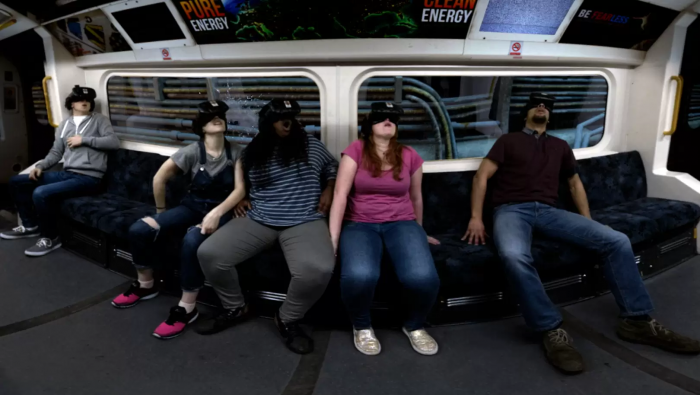
This is all done on a relatively small budget compared to what Disney pours into their attractions, but it creates a spectacular effect. Here, VR is used to enhance physical effects (which are as simple as an actor brushing your knee), and create situations that would be impossible to produce with practical effects (like watching your fellow riders get attacked by a monster). The special effects, fixed perspectives, and in-universe justification for the goggles make the experience seem much more than just a hokey VR demonstration you downloaded off Steam. Imagine, for instance, a VR enhanced version of ExtraTERRORrestrial: Alien Encounter. There’s already an in-universe justification for wearing goggles (as you’re in the middle of a teleportation demo), and the ride already features elaborate physical effects. A well-made VR movie could add to the immersion; it could still rely on the lack of visibility and fear of the unseen, but the alien could also perform feats that would be impossible for a normal animatronic. They could even add in multiple shows with different outcomes, as it’s easier to change ride movies than it is to program an animatronic with different movements! We’re excited to see how Disney utilizes this technology in the future… but there’s a sister technology we’re even more excited about.
Mixed Reality
If you’ve ever played Pokémon GO, you’re familiar with this technology. It’s when a computer program projects virtual objects into the real world through a camera and a computer screen. It’s different from augmented reality, in that it’s not augmenting anything. An augmented reality app would be something like Snapchat, which applies filters to your face in real time; it’s using the program to change what’s already there. Mixed reality creates something that was never there to begin with and makes it appear real!
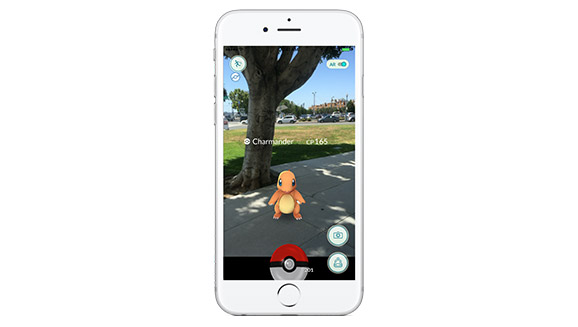
Currently, mixed reality is largely limited to screens. It takes a lot of computing power to make it work… arguably more than VR does. VR works a lot like first person video games. The only difference is that you control the camera with your head. The hardware has to track your head movements and occasionally the movements of your hands and body. Most of the processing power beyond that is focused on graphics, physics, and logic, like any video game. If you use a 360 degree movie, like Derren Brown’s Ghost Train does, it doesn’t take much processing power at all. Mixed reality, on the other hand, has to keep track of you and all of your surroundings to realistically add in virtual elements. This is on top of everything else. That’s why a lot of existing MR applications don’t look very realistic. Play Pokémon GO, and reach your hand out toward the Pokémon in AR mode. Rather than covering the creature, your hand will seem to go underneath it. That’s because your cell phone, even if it’s a brand new model, simply doesn’t have the capacity to place the model in a fixed point in space, gauge its distance in 3D, and accurately react to other objects moving in between the camera and the object. It makes a rough approximation of where the Pokémon should be, what its surroundings are, and how far away it is, and then projects it over the footage your phone is recording. Your phone can’t accurately scan your entire environment, provide a high resolution image, and render a 3D model in real-time while also functioning as a phone. It’s not impossible, it just requires dedicated hardware to do effectively.
Companies like Magic Leap and Microsoft are already working on mixed reality glasses that are portable enough for general use, but they still suffer from similar problems. Not to mention, since these glasses use an effect similar to the Pepper’s Ghost to project images over the lenses, things tend to look more transparent than they’d otherwise be. To make truly realistic mixed reality effects, we’d need much more powerful hardware that simply isn’t portable right now.
Or, we could lean into the limitations. One advantage that theme parks have over home users is that they can tailor their MR programs to the environment. Guests on rides often have a limited range of mobility, making it easier to direct the eye to set pieces where the MR effect will look most realistic. Lighting can also be used to reduce the transparency of the Pepper’s Ghost effect. It’s difficult to notice something is transparent if there’s nothing behind it to see, after all. Even hardware issues can be overcome by building computers into the ride vehicles themselves, providing more processing power than a self-contained pair of glasses would normally be able to. The result would be a ride experience like no other, where the virtual and the physical combine into one seamless experience.
Haptic Feedback
You’ve probably already encountered haptic feedback if you own a modern smartphone or video game system. If you own a Nintendo Switch, try playing just about any game with the JoyCon controllers. You can actually feel your character knocking on doors in Animal Crossing or flipping steaks in Super Mario Party. Haptic feedback is the process of using technology to stimulate our sense of touch. It’s something that Disney is pretty familiar with as well. Classic rides like ExtraTERRORrestrial: Alien Encounter, It’s Tough to be a Bug, and Honey, I Shrunk The Audience use haptic feedback to create various tactile illusions. Even more recent rides, like Runaway Railway, use it to simulate the bumps and jumps your ride vehicle goes through.
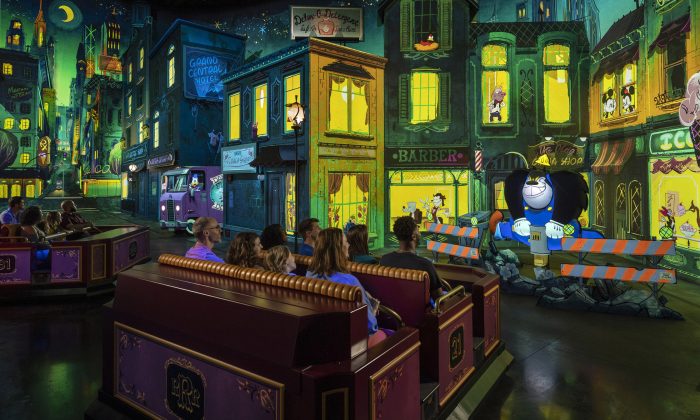
However, while Disney’s use of haptic feedback is remarkably convincing, it’s currently all scripted. Guests on Honey, I Shrunk the Audience would famously take measures to block or otherwise avoid the “rat swarm” effect, by blocking out the gusts of air that simulated thousands of mice crawling over your feet. The dream of haptic technology is being able to combine it with VR and MR to create a totally immersive virtual experience.
As mentioned above, touch is the biggest sensory weakness when it comes to VR. It’s the sense used to orient ourselves in physical space, and which we use to ground ourselves in abnormal situations. Yet when you use VR, you pass through most objects like a ghost. The dream is to use things like gloves, vests, or even precisely controlled jets of air and audio-vibrations, to create the illusion of physical presence when something isn’t really there. Imagine seeing a character in mixed reality and reaching out to shake their hand, only to actually feel it.
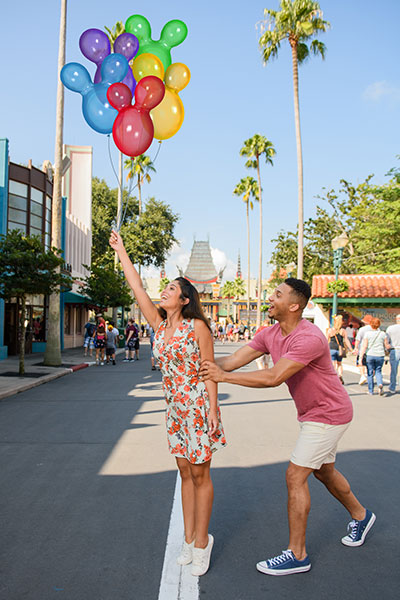
This “force field” style of haptic technology isn’t that far off, but we’ve still got some way to go before we can accurately simulate texture. However, other forms of situational haptic technology are already planned for upcoming attractions. One example? A shockwave plate!
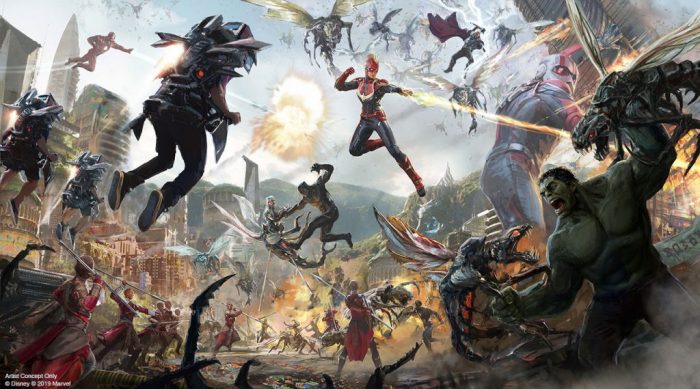
Meant to simulate the impact of a large object hitting the ground (Iike The Hulk, for instance), this specialized floor shakes and rumbles, accurately simulating the point of impact. Imagine being in a room overlooking a wild superhero fight on simulated windows, feeling every impact! We might not be quite at magic force fields yet, but there’s still a lot that haptic technology can do!
BLACK BOX RIDES
This last one is a combination of several other ideas. It’s also one that is actually already in progress! A black box ride gets its name from how it normally looks… an empty black warehouse with some projection screens and a trackless ride vehicle. Sounds riveting, doesn’t it?
Well, the real magic is that these rides can easily be adapted to different ride experiences. In fact, there are rides like this that already exist!
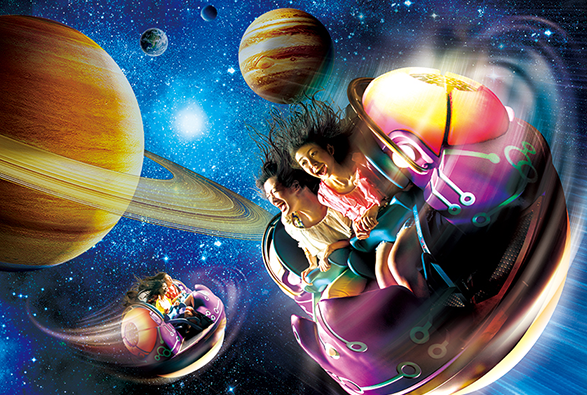
Space Fantasy, a spinning coaster at Universal Studios Japan, isn’t a true black box ride. Instead, every summer, it’s equipped with Virtual Reality headsets and a new queue overlay that theme it to a popular IP as part of Universal’s Cool Japan event. In the past few years, it’s been themed to Final Fantasy, Lupin the Third, and J-Pop Idol Kyary Pamyu Pamyu, most famous in the US for her surreal “PONPONPON” music video. These overlays only last for the summer but ensure the park has a fresh attraction every year.
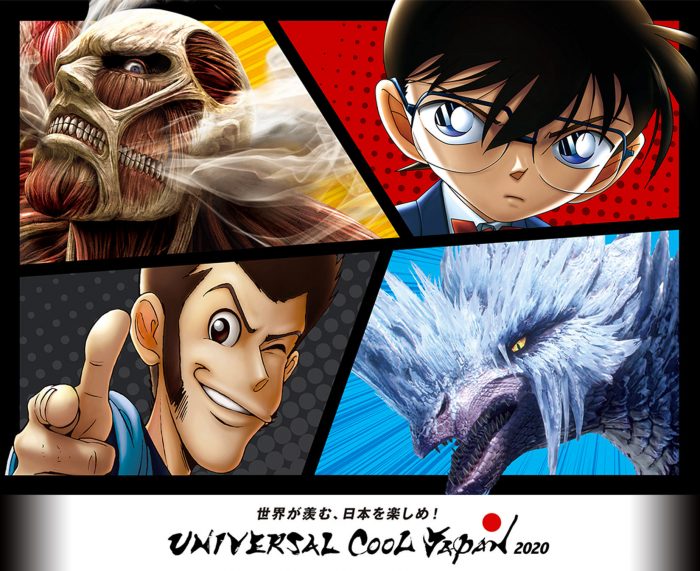
Disney’s plans for black box attractions could be a bit more ambitious than slapping a VR headset on a roller coaster, however. Using trackless ride vehicles and projection mapping, Disney can create a Runaway Railway-style experience that can be easily rethemed to fit whatever experience Disney wants to create. Imagine special rides for EPCOT’s various festivals or for Halloween and Christmas? Other technologies on this list, like VR, Haptics, and Mixed Reality can be used to augment the experience further, being added in or removed as needed to ensure the ride experience is radically different with every overlay.

